Medals relating to Boston
As always, you can click or tap medals to see the reverse. Some medals might have multiple variants that differ in material, size, or other details. If multiple variants are available you can drag or slide medals sideways to display them.
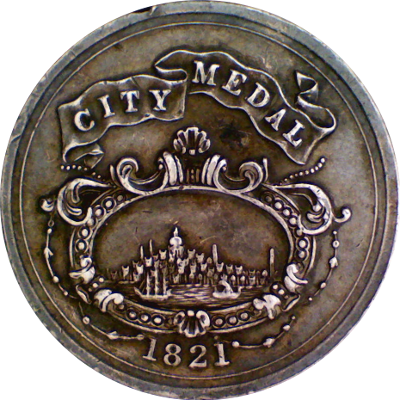
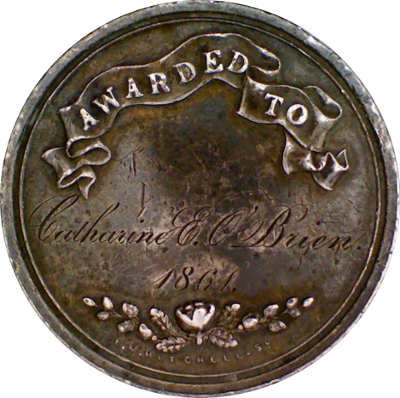
The obverse bears Boston silhouette in decorated medallion. Above, CITY MEDAL; below, 1821.
The reverse bears banner and flowers. In banner, AWARDED / TO; below, F. W. MITCHELL, SC. This medal is dedicated to Catharine E. O'Brien and is dated 1861.
Benjamin Franklin was born in Boston and briefly attended the public grammar school there before he left for Philadelphia to join his brother. When Franklin died, he left £100 sterling to the City of Boston for medals to be given to the best boys in the then 7 public schools (3 to each school, for a total of 21 per year initially). These medals were first awarded in 1792 and were the prototypes of all school medals that followed.
By 1821 girls were now also attending the public schools and it was regarded as unfair to exclude them from merit awards. As only boys were attending public grammar school at the time Franklin had made his will, the School Committee reasoned that he probably meant "children" when he wrote "boys." They therefore created a new medal that was awarded to girls.
In 1821 Boston was still officially a town, so the banner read "Town Medal." In 1822 Boston became a city and the medal was updated to account for that change.
The medal measures 34mm in diameter and was struck by the United States Mint.
References: Julian SC-11, SC-12


This medal's obverse bears three robed female figures, two seated ones flanking standing one in the middle. In exergue, incuse inscription: DESMOND FITZGERALD MEDAL / INSTITUTED 1910
The reverse bears laurel branches behind ninscribed cartouche at bottom. Around, BOSTON SOCIETY OF CIVIL ENGINEERS; in center field, AWARDED / FOR BEST ESSAY / IN ENGINEERING / TO
This beautiful medal was commissioned by Desmond Fitzgerald, a past President of the Society, to honor the author of the best paper published by a member of the Society during the year ending in the month of September. He donated the tidy sum of $2,000 to fund the medal. He reasoned that a medal wold be the best form for such a prize because the prize should be valued not for its intrinsic worth but solely as
"a testimonial that the holder of it has contributed something which his fellow members consider of great value to the engineering profession also that the evidence of having received such an award will be more available and less likely to be deposited where it can seldom be seen if the medal is of bronze rather than of precious metal."
The medal has a diameter of 76.3mm and was struck in bronze by the U.S. Mint. Mint records indicate that 18 pieces were struck at the order of Brenner in November of 1911.
References: Hahlo 44, 60

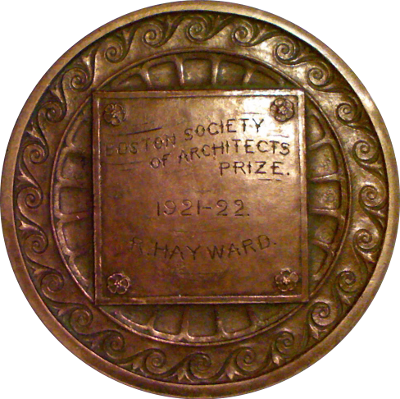
The obverse bears bust of Greek woman with long braided hair before columns. Around, (*) MASSACHUSETTS INSTITUTE OF TECHNOLOGY (*) / DEPARTMENT OF ARCHITECTURE
The reverse bears decorative border with cresting waves around square center panel with engraved dedication, BOSTON SOCIETY / OF ARCHITECTS / PRIZE. / 1921-22. / R. HAYWARD.
The edge is marked GORHAM CO.
Roger Hayward (1899-1979) was a talented artist, architect and inventor. Hayward won this award while he was still a student at MIT. After working as an architect for a few years he moved to California and worked with Linus Pauling, for whom he illustrated many books and journal publications. He is also remembered as an expert in the field of optics and played an important role in the development of the Schmidt-Cassegrain telescope.
The dies for this medal were used by MIT for a number of different awards, including the F.W. Chandler Prize and the School Medal Prize, with the hand-engraved inscription being appropriately worded for each.
The medal was struck in bronze by Gorham Co. Neither mintage nor artist are known.


This medal's obverse bears bust of Curley facing three quarters left. Around, GOVERNOR JAMES MICHAEL CURLEY; signed above shoulder at right, Parafino / Sc.
This medal's reverse bears a summary of Curley's public service career surrounded by laurel wreath, seal of the Commonwealth at bottom. Inscription reads MEMBER / OF / BOSTON / COMMON COUNCIL / 1900 - 1901 / MASS. HOUSE OF REPRESENTATIVES / 1902 - 1903 / BOARD OF ALDERMEN / 1904 - 1905 · 1906 - 1907 · 1908 - 1909 / CITY COUNCIL 1910 - 1911 / 62nd AND 63rd CONGRESS 1911- 1915 / MAYOR OF BOSTON / 1914 - 1917 · 1922 - 1925 · 1930 - 1933 / GOVERNOR OF MASSACHUSETTS / 1935 - 1936
James Michael Curley (1874-1958) was one of the most colorful Massachusetts politicians ever and a perfect example of the old-style machine politics of the first half of the 20th century. He rose from poverty to become councillor, member of the House, Mayor of Boston, and even Governor of Massachusetts.
His legendary popularity includes getting elected into public office while serving jail terms for fraud, corruption, and bribery. While the legal troubles gave him a bad reputation among the old upper class Wasps of Boston, the increasingly numerous and vocal Irish immigrant class unfailingly supported him during his career.
In one popular stunt, while Governor of Massachusetts, he appeared at the Harvard University commencement ceremony wearing silk stockings, knee britches, a powdered wig, and a three-cornered hat with flowing plume. When University marshals objected to his costume, the story goes, Curley whipped out a copy of the Statutes of the Massachusetts Bay Colony which prescribed proper dress for the occasion and claimed that he was the only person at the ceremony properly dressed, thereby endearing him to many working and middle class Yankees.
Unlike many other local politicians, James Michael Curley has not been forgotten. Curley is widely believed to have been the model for protagonist Frank Skeffington in the Edwin O'Connor novel "The Last Hurrah". Spencer Tracey portrayed Skeffington in a John Ford film based on the novel. Since Curley, every Boston mayor has been driven in a car with the license registration 576, representing the number of letters in his first, middle, and last name: James (5) Michael (7) Curley (6). The Curley family still holds Massachusetts auto registration number 5. It is owned by his step-son Richard.
The round medal measures 76.2mm in diameter and was struck in bronze by the Medallic Art Company of New York. Its mintage is not reported.
References: MACo 1936-037


This commissioned medal's shows Arthur Fiedler facing right. Top right circumference, ARTHUR FIEDLER; Arthur Fiedler's signature in bottom right quadrant; below, signed Miko K. The reverse bears the Boston Symphony's crest. In center field, BOSTON / SYMPHONY / ORCHESTRA / 1978.
Arthur Fiedler was the long-time director of the Boston Pops Orchestra, a symphony orchestra that specializes in popular and light classical music.
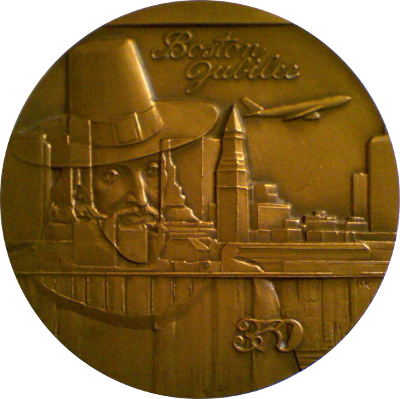
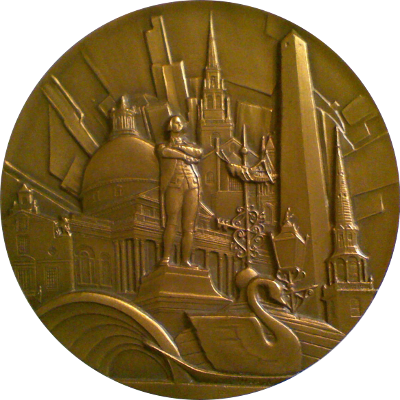
The medal's obverse bears a bearded pilgrim over modern Boston skyline. Across at top, "Boston Jubilee"; below, 350; signed MK
The reverse holds a mosaic of Boston sites and landmarks, including the State House, the Bunker Hill monument, North Church, a Swan boat, and the half shell.
The medal was struck by Monnaie de Paris in an edition of 9,500 solid bronze pieces.